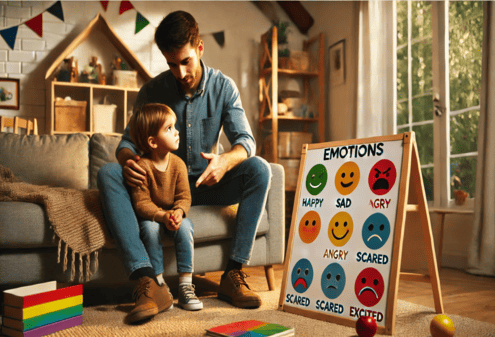Helping children understand and express their emotions is one of the most powerful tools you can give them. Emotional intelligence starts in early childhood and plays a key role in healthy relationships, problem-solving, and self-regulation throughout life.
Talking about emotions in a supportive and age-appropriate way builds your child’s confidence, empathy, and communication skills. In this article, you’ll learn simple strategies to make emotional conversations a natural part of your daily routine.
Why Talking About Emotions Matters
Children who learn to identify and express emotions:
- Handle stress and frustration better
- Build stronger relationships
- Develop empathy and compassion
- Communicate needs clearly
- Show more resilience in difficult situations
Emotional vocabulary is just as important as numbers and letters. It helps children understand themselves—and others.
Start Early with Simple Words
Even toddlers can begin learning to name their feelings. Use basic words and expressions to talk about emotions:
- Happy
- Sad
- Angry
- Scared
- Excited
- Frustrated
- Tired
Use facial expressions and tone of voice to reinforce meaning:
- “You’re smiling! Are you feeling happy?”
- “Your face looks like this… are you feeling sad?”
The earlier children hear emotional words, the more easily they’ll use them.
Talk About Your Own Feelings
Children learn from what they see and hear. By modeling emotional expression, you normalize talking about feelings.
For example:
- “I’m feeling a little tired today, so I’m going to rest for a bit.”
- “I felt proud when you shared your toys.”
- “I got frustrated earlier, but I took deep breaths to calm down.”
When you share honestly and calmly, your child learns that emotions are okay and manageable.
Use Storybooks and Play
Books are powerful tools for emotional education. Choose stories with relatable characters who go through challenges and feelings.
After reading, ask:
- “How do you think the character felt?”
- “What would you do in that situation?”
- “Have you ever felt like that?”
Pretend play with dolls, animals, or figures is another great way to explore emotions. Let your child act out different feelings through stories and characters.
Create a Safe Space for Expression
Children are more likely to share when they feel accepted and safe. Avoid judging or minimizing their emotions.
Instead of:
- “Don’t cry, it’s not a big deal.”
Try:
- “I see that you’re upset. Want to tell me what happened?”
Offer comfort without trying to fix everything immediately. Sometimes, listening is all they need.
Teach That All Emotions Are Okay
Let your child know that it’s okay to feel the full range of emotions—even the hard ones.
Say things like:
- “It’s okay to be angry, but we don’t hit.”
- “Everyone feels scared sometimes. You’re not alone.”
- “Crying is a way your body lets out big feelings.”
Helping your child accept emotions without shame builds emotional strength.
Practice Naming Emotions in Real Time
Use daily situations to name and discuss feelings:
- “You’re jumping up and down—you look excited!”
- “It’s hard to stop playing, huh? Are you feeling frustrated?”
- “You seem quiet. Are you feeling sad or tired?”
When you narrate emotions like this, you help your child make sense of their inner world.
Teach Simple Coping Strategies
Once children can name their emotions, teach them what to do with those feelings.
Some age-appropriate strategies:
- Deep breathing
- Hugging a stuffed animal
- Drawing how they feel
- Listening to calm music
- Asking for help
- Quiet time in a cozy space
Practice these when your child is calm so they’re ready to use them in harder moments.
Celebrate Emotional Wins
When your child expresses feelings in a healthy way, celebrate it!
Say things like:
- “I’m proud of you for telling me how you feel.”
- “You stayed calm even when you were upset—that’s really hard!”
- “You used your words instead of yelling. That was awesome.”
Positive reinforcement encourages continued emotional growth.
Final Thoughts: Emotions Are a Superpower
Teaching your child about emotions isn’t a one-time conversation—it’s a lifelong process. By talking openly, listening deeply, and offering tools for emotional expression, you’re giving your child the skills to thrive.
When children feel seen and heard emotionally, they feel safe to be themselves. And that emotional safety becomes the foundation for confidence, empathy, and resilience.
